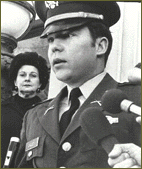|
|
MARCH 16th 1968 MY LAI MASSACRE
"Nothing needs to be said, and nothing can be said"
My Lai Massacre
The villages of central Vietnam known collectively as My Lai have been stamped by history as places of horrific acts of war. More than 500 people, many of them women and children , were slaughtered here by American G.I.s on March 16, 1968. On that fateful day the angry and frustrated men of Charlie Company, 11th Brigade, Americal Division entered the village of My Lai. "This is what you've been waiting for -- search and destroy -- and you've got it," said their superior officers. A short time later the killing began. When news of the atrocities surfaced, it sent shockwaves through the US political establishment, the military's chain of command, and an already divided American public.
My Lai lay in the South Vietnamese district of Son My, a heavily mined area of Vietcong entrenchment. Numerous members of Charlie Company had been maimed or killed in the area during the preceding weeks. The agitated troops, under the command of Lt. William Calley, entered the village poised for engagement with the elusive Vietcong.
As the "search and destroy" mission unfolded it soon degenerated into the massacre of over 300 apparently unarmed civilians including women, children, and the elderly. Calley ordered his men to enter the village firing, though there had been no report of opposing fire. According to eyewitness reports offered after the event, several old men were bayoneted, praying women and children were shot in the back of the head, and at least one girl was raped, and then killed. For his part, Calley was said to have rounded up a group of the villagers, ordered them into a ditch, and mowed them down in a fury of machine gun fire.
Word of the massacre did not reach the American public until November of 1969, when journalist Seymour Hersh published a story detailing his conversations with ex-GI and Vietnam veteran, Ron Ridenhour. Ridenhour learned of the events at My Lai from members of Charlie Company who had been there. Before speaking with Hersh, he had appealed to Congress, the White House, and the Pentagon to investigate the matter. The military investigation resulted in Calley's being charged with murder in September 1969 -- a full two months before the Hersh story hit the streets.
As the gruesome details of the massacre reached the American public serious questions arose concerning the conduct of American soldiers in Vietnam. A military commission investigating the My Lai massacre found widespread failures of leadership, discipline, and morale among the Army's fighting units. As the war progressed, many "career" soldiers had either been rotated out or retired. Many more had died. In their place were scores of draftees whose fitness for leadership in the field of battle was questionable at best. Military officials blamed inequities in the draft policy for the often slim talent pool from which they were forced to choose leaders. Many maintained that if the educated middle class ("the Harvards," as they were called) had joined in the fight, a man of Lt. William Calley's emotional and intellectual stature would never have been issuing orders.
 Calley, an unemployed college dropout, had managed to graduate from Officer's Candidate School at Fort Benning, Georgia, in 1967. At his trial, Calley testified that he was ordered by Captain Ernest Medina to kill everyone in the village of My Lai. Still, there was only enough photographic and recorded evidence to convict Calley, alone, of murder. He was sentenced to life in prison, but was released in 1974, following many appeals. After being issued a dishonorable discharge, Calley entered the insurance business. Calley, an unemployed college dropout, had managed to graduate from Officer's Candidate School at Fort Benning, Georgia, in 1967. At his trial, Calley testified that he was ordered by Captain Ernest Medina to kill everyone in the village of My Lai. Still, there was only enough photographic and recorded evidence to convict Calley, alone, of murder. He was sentenced to life in prison, but was released in 1974, following many appeals. After being issued a dishonorable discharge, Calley entered the insurance business.

Lt. William Calley is escorted to the Fort Benning stockade on March 31, 1971 to begin his lifeterm in prison for his part in the My Lai massacre during the Vietnam War. Calley's sentence was later reduced and he was released on parole in November 1975.
|
|
|
|
|
 Vietnam War History
Vietnam War History
